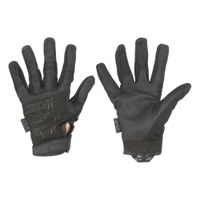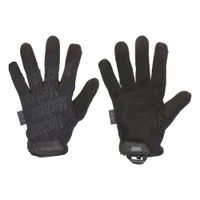Call +(254) 703 030 000 / 751 483 999 / 721 704 777
- Home
- Security
- Military Tactical Public Security Equipment
- Clothing Protective Equipment For Military Ems Law Enforcement
- Military Law Enforcement Tactical Gloves
.....Read More
Frequently Asked Questions
What are the best tactical gloves for military use?
The best tactical gloves for military use are those that offer a combination of durability, dexterity, protection, and comfort. Some top options include:
1. **Mechanix Wear M-Pact Gloves**: Known for their durability and protection, these gloves feature thermoplastic rubber (TPR) knuckle guards and finger guards to protect against impact and abrasion. The dual-layer internal fingertip construction enhances durability, while the D3O palm padding absorbs shock and vibration.
2. **Oakley Factory Pilot Gloves**: These gloves are popular for their rugged construction and flexibility. They have carbon fiber knuckle plating for protection and a micro-vented leather palm for breathability. The secure fit and dexterity make them suitable for handling weapons and equipment.
3. **PIG Full Dexterity Tactical (FDT) Delta Utility Gloves**: Designed for maximum dexterity, these gloves allow for precise handling of firearms and equipment. They feature a single-layer multi-piece palm for better grip and touch screen compatible fingertips.
4. **5.11 Tactical Hard Time Gloves**: These gloves offer excellent protection with their Kevlar-reinforced knuckles and fingers. The goatskin leather palm provides a good grip, while the breathable stretch nylon back ensures comfort.
5. **Hatch Operator HK Tactical Gloves**: Made with goatskin leather and Kevlar, these gloves offer a balance of protection and dexterity. The ergonomic design and touchscreen compatibility make them versatile for various military tasks.
When choosing tactical gloves, consider the specific requirements of your mission, such as climate, terrain, and the need for touchscreen compatibility. The right pair should enhance performance while providing the necessary protection and comfort.
How do tactical gloves protect against hazards?
Tactical gloves protect against hazards through several key features:
1. **Impact Resistance**: Many tactical gloves are designed with reinforced knuckles and padding on the back of the hand. These features absorb and distribute the force from impacts, protecting the wearer from blunt force injuries.
2. **Cut Resistance**: Tactical gloves often incorporate materials like Kevlar or Dyneema, which are resistant to cuts and abrasions. This is crucial for protection against sharp objects, reducing the risk of lacerations.
3. **Puncture Resistance**: Some gloves are designed to resist punctures from needles or other sharp objects, providing an additional layer of safety in environments where such hazards are present.
4. **Heat and Flame Resistance**: Certain tactical gloves are made from materials that can withstand high temperatures and are flame-resistant, protecting the wearer from burns in situations involving fire or extreme heat.
5. **Grip and Dexterity**: The palms of tactical gloves are often textured or made from materials that enhance grip, even in wet conditions. This ensures that the wearer can maintain control of tools and weapons, reducing the risk of accidents.
6. **Chemical Resistance**: Some tactical gloves are treated or made with materials that resist chemical exposure, protecting the skin from harmful substances.
7. **Weather Protection**: Tactical gloves can also provide insulation against cold weather, keeping hands warm and functional in extreme conditions.
8. **Enhanced Sensory Feedback**: Despite their protective features, many tactical gloves are designed to allow for tactile sensitivity, enabling the wearer to perform delicate tasks without removing the gloves.
These features collectively ensure that tactical gloves offer comprehensive protection against a variety of physical, environmental, and chemical hazards, making them essential for military, law enforcement, and other high-risk professions.
What features should I look for in law enforcement gloves?
When selecting law enforcement gloves, consider the following features:
1. **Durability**: Look for gloves made from high-quality materials like Kevlar, leather, or synthetic blends that withstand wear and tear.
2. **Cut Resistance**: Ensure the gloves offer protection against cuts and slashes, often achieved with materials like Kevlar or Spectra.
3. **Puncture Resistance**: Choose gloves that can protect against needle sticks and other sharp objects, often reinforced with specialized materials.
4. **Grip**: Opt for gloves with textured palms or fingers to maintain a firm grip on weapons, tools, or suspects, even in wet conditions.
5. **Dexterity**: Ensure the gloves allow for precise finger movements, crucial for handling firearms, radios, or other equipment.
6. **Comfort and Fit**: Look for gloves that fit snugly without being too tight, with features like adjustable wrist closures for a secure fit.
7. **Breathability**: Choose gloves with breathable materials or ventilation to prevent sweating and discomfort during extended wear.
8. **Weather Resistance**: Consider gloves that offer protection against cold, heat, or moisture, depending on the operational environment.
9. **Touchscreen Compatibility**: If using electronic devices, select gloves with touchscreen-compatible fingertips.
10. **Chemical Resistance**: For certain operations, gloves should protect against hazardous chemicals or substances.
11. **Fire Resistance**: In high-risk situations, consider gloves with fire-resistant properties.
12. **Ease of Cleaning**: Opt for gloves that are easy to clean and maintain, ensuring longevity and hygiene.
13. **Weight**: Lightweight gloves can reduce fatigue during long shifts.
14. **Cost**: Balance quality and budget, ensuring the gloves meet operational needs without overspending.
15. **Compliance**: Ensure the gloves meet any relevant industry standards or regulations for law enforcement gear.
Are leather gloves suitable for tactical operations?
Leather gloves can be suitable for tactical operations, but their appropriateness depends on specific requirements and conditions. Leather is durable, providing good protection against abrasions, cuts, and punctures, which is beneficial in rugged environments. It also offers a decent grip, which is crucial for handling weapons and equipment.
However, leather gloves have limitations. They can be less breathable than synthetic materials, potentially leading to sweaty hands, which might affect grip and comfort during prolonged use. Leather is also not inherently flame-resistant, which could be a concern in operations involving fire hazards. Additionally, leather can become stiff and less flexible when wet, impacting dexterity.
Modern tactical gloves often incorporate leather with other materials like Kevlar, Nomex, or synthetic fabrics to enhance performance. These combinations can offer improved cut resistance, flame resistance, and better moisture management while maintaining the protective qualities of leather.
Ultimately, the suitability of leather gloves for tactical operations depends on the specific mission requirements, environmental conditions, and personal preferences. For optimal performance, operators might choose gloves that blend leather with advanced materials to balance protection, dexterity, and comfort.
How do mechanics-style gloves differ from other tactical gloves?
Mechanics-style gloves and tactical gloves serve different purposes and are designed with distinct features to meet specific needs.
Mechanics-style gloves are primarily designed for tasks that require dexterity and protection from mechanical hazards. They typically feature:
1. **Material**: Often made from synthetic leather, spandex, and neoprene, providing flexibility and breathability.
2. **Dexterity**: High dexterity for handling tools and small parts, with a snug fit to enhance precision.
3. **Protection**: Reinforced palms and fingers to protect against cuts, abrasions, and impacts.
4. **Grip**: Enhanced grip surfaces for handling oily or slippery objects.
5. **Comfort**: Lightweight and comfortable for extended wear, often with moisture-wicking properties.
Tactical gloves, on the other hand, are designed for military, law enforcement, and outdoor activities, focusing on protection and functionality in various environments. They typically feature:
1. **Material**: Made from durable materials like Kevlar, Nomex, or leather, offering resistance to heat, cuts, and abrasions.
2. **Protection**: Enhanced protection with knuckle guards, reinforced padding, and sometimes flame resistance.
3. **Grip and Control**: Textured surfaces for improved grip on weapons and equipment.
4. **Versatility**: Designed for a range of activities, including shooting, climbing, and tactical operations.
5. **Weather Resistance**: Often water-resistant or waterproof, with insulation for cold weather conditions.
In summary, mechanics-style gloves prioritize dexterity and comfort for precision tasks, while tactical gloves emphasize protection, durability, and versatility for demanding environments.
What materials are used in tactical gloves for durability?
Tactical gloves are designed for durability and protection in demanding environments. Key materials used include:
1. **Kevlar**: Known for its high tensile strength, Kevlar is often used in the construction of tactical gloves to provide cut and abrasion resistance. It is lightweight yet incredibly strong, making it ideal for protective gear.
2. **Nomex**: This flame-resistant material is used in gloves for environments where heat and fire protection are crucial. Nomex maintains its integrity under high temperatures, providing safety for the wearer.
3. **Leather**: Often used in the palm and finger areas, leather offers excellent grip, durability, and protection. It is resistant to wear and tear, making it a staple in tactical glove design.
4. **Synthetic Leather**: Provides similar benefits to natural leather but with added water resistance and flexibility. It is often used in combination with other materials for enhanced performance.
5. **Neoprene**: This synthetic rubber is used for its flexibility and resistance to water, oil, and heat. Neoprene is often used in the cuff area for a snug fit and to keep out debris.
6. **Thermoplastic Rubber (TPR)**: Used for knuckle and finger protection, TPR provides impact resistance and flexibility. It is often molded into protective panels on the gloves.
7. **Microfiber**: Utilized for its softness and durability, microfiber is often used in areas requiring dexterity and sensitivity, such as the fingertips.
8. **Spandex**: Incorporated for its elasticity, spandex allows for a snug fit and flexibility, ensuring the gloves move with the wearer’s hands.
These materials are often combined in various ways to create gloves that offer protection, dexterity, and comfort, tailored to specific tactical needs.
How do I choose the right size for tactical gloves?
To choose the right size for tactical gloves, follow these steps:
1. **Measure Your Hand**: Use a flexible tape measure. Wrap it around your dominant hand just below the knuckles, excluding the thumb. Note the circumference in inches or centimeters.
2. **Check Sizing Charts**: Different brands have varying sizing charts. Compare your hand measurement with the brand's chart to determine your size. Sizes typically range from XS to XXL.
3. **Consider Finger Length**: Measure from the base of your palm to the tip of your middle finger. Ensure the glove's finger length matches your measurement for a snug fit.
4. **Try Them On**: If possible, try the gloves on. Ensure they fit snugly but not too tight. You should be able to move your fingers freely without excess material bunching up.
5. **Check for Dexterity**: Perform tasks like picking up small objects or making a fist to ensure the gloves allow for dexterity and flexibility.
6. **Consider Material Stretch**: Some materials, like leather, may stretch over time. Consider this when choosing a size.
7. **Purpose and Features**: Consider the glove's intended use. If you need extra padding or insulation, ensure the size accommodates these features without compromising fit.
8. **Read Reviews**: Check online reviews for insights on sizing accuracy and fit from other users.
9. **Return Policy**: Ensure the retailer has a good return policy in case the gloves don't fit as expected.
10. **Brand Consistency**: Stick to brands you’ve used before if they fit well, as sizing can be consistent across their products.
By following these steps, you can select tactical gloves that offer comfort, protection, and functionality.

